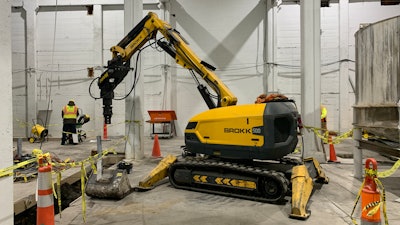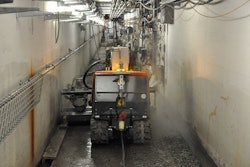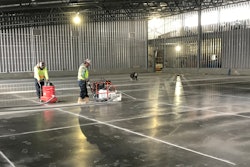
When it comes to fast, efficient deep foundation systems, helical piers are gaining traction with contractors across the country. This anchoring method offers minimal ground disturbance and leaves no spoils. There’s also no cure time involved — unlike micro piles or other systems —allowing for immediate loading and accelerated project timelines.
However, achieving these benefits often comes with site-specific challenges, especially in retrofit applications. While helical piers might provide an ideal solution, finding electric equipment with the necessary power-to-weight ratio to access emission-restricted spaces, such as basements and older buildings with low floor loads, can be difficult.
It’s a problem St. Louis-based Drilling Service Co. faced on a recent warehouse retrofit near the city’s The Hill neighborhood. At first glance, the brief seemed straightforward — retrofit a 100-plus-year-old manufacturing facility to support new equipment with heavier loads than the building was designed for. However, site-specific challenges quickly piled up, resulting in a more complex project.
The single-story warehouse, located in a traditionally industrial neighborhood near the river, likely sat on contaminated soil, requiring an installation method that limited spoils. In addition, the facility wouldn’t allow the use of diesel-powered equipment within the building. This meant that even though there was plenty of room to maneuver larger diesel-powered equipment, the selected contractor would need to find an electric solution.
The project’s general manager approached Drilling Service Co. based on its long history of delivering intelligent, efficient and effective underground solutions. The family-owned company, now in its third generation, has been serving the St. Louis area for 66 years. During that time, the company has invested heavily in people and cutting-edge technology, remaining at the forefront of the drilling industry by embracing new methods to provide safe, efficient results.
“Since our founding in 1955, Drilling Service Co. has always been focused on finding the very best way to do the work,” says Kyle Murphy, project engineer for Drilling Service Co. “The business grew from there. People knew that they would be treated fairly and that we could be trusted to provide cost-effective solutions for even the most challenging applications. We built relationships with general contractors across the region based on our integrity and ability to deliver innovative results.”
Exploration into Robotics
For a company synonymous with quality, customer-focused solutions for drilled shafts, dewatering systems, earth retention, micro piles, rock anchors and more, the warehouse retrofit presented a unique opportunity to explore an exciting new process — robotic helical pier installation.
“At heart, we’re a company of problem solvers who is always looking for new ways to increase safety and efficiency,” Murphy says. “Everyone on the team brings their best ideas to the table. When we were approached with this project, we recognized it as an opportunity to explore new equipment options.”
Installing helical piers requires a robust hydraulic system and a specialized drive head that can provide not only downward force, but rotational pressure. Drilling Service Co. would traditionally run the drive head from the auxiliary hydraulics of a mini-excavator or skid steer, but with the zero-emission requirement, they knew they’d have to come up with a creative solution.
The project required driving large helical piers consisting of 4.5-in.-diameter pipe with a 16-in.-diameter helical plate from 20 to 25 ft. down to refuse on bedrock. After establishing the required loads, Drilling Service Co. reached out to Ideal Group, the helical pier designer and manufacturer, to discuss equipment options.
“Ideal connected us with Brokk,” Murphy says. “They were using a Brokk 520D, weighing in at approximately 12,000 lbs., to test their larger helical piers in confined spaces. Not only did it provide the necessary torque, but the unique arm design meant it still had enough downward pressure to operate in low-overhead situations, like a basement. That wasn’t one of our concerns with this particular project, but the electric operation was.”
Drilling Service Co. worked with Brokk to arrange a one-month rental of a Brokk 500. Ideal Group provided a Digga with a 30ADS anchor drive head and custom mounting bracket.
With the rental, Brokk provided training for Drilling Service Co. employees at their St. Joseph, Missouri, demonstration and service center. The Drilling Service Co. team had extensive experience with hydraulic drilling equipment, which gave them some familiarity with the basic functions. However, working with the Brokk robot’s remote operation gave them a new perspective, allowing them to stand back and observe installation from a safe distance. The training covered specifics of the Brokk machine including maneuvering it, setting the outriggers, operating the arm and running the drive head.
Ability to Overcome Surprises and Obstacles
With its team trained and the helical piers delivered, Drilling Service Co. was ready to get to work. The general contractor started by saw cutting an approximately 2-ft.-wide section in the 6-in.-thick floor slab running the length of each new grade beam to expose the soil below. However, plans quickly hit a snag when the crew discovered a layer of urban rubble less than a foot below the slab.
“We were surprised to find grapefruit- to beachball-sized fragments of cement, brick and old rebar from demolished buildings,” says Mat Boster, project superintendent for Drilling Service Co. “The helical only has a small pitch. It could have advanced through gravel-sized rubble, but this was too large.”
Drilling Service Co. quickly revised its plan. Before installing the piers, the team needed to pre-drill holes through the rubble, which was between 10 to 12 ft. thick. Attaching a 16-in.-diamter core barrel and auger to the drive head, the team simply used the Brokk to drill through the rubble to the soil below.
“The Brokk worked great for pre-drilling,” Boster says. “It cut through the rubble quickly, so we didn’t lose much time, and had more than enough power for this application as well as driving the helical piers.”
Once the machine had created a void through the rubble, the lead of the helical pier was driven through the soil below until it reached bedrock. Then, 5- and 10-ft. sections were added as installation progressed, with the team constantly monitoring the drive head and hydraulic pressure for optimal torque output.
The Brokk 500’s 23-ft. reach allowed the team to access helical pier locations that would have been challenging with traditional monoboom equipment. This included reaching up, over or around existing equipment in the building when necessary. The 41-kW motor was easily powered by a 100-kW generator positioned outside the building.
With pier installation complete, Drilling Service Co. capped the end of each pipe. The general contractor then cast the capped pipe into a grade beam that was reinforced with rebar, becoming the foundation for the facility’s new equipment.
More than half of the 46 helical pier positions needed to be pre-drilled. Thanks to the professionalism of the team and the versatility of the Brokk, the work progressed quickly, allowing Drilling Service Co. to complete the entire project in just three weeks.
Piling on the Projects
With a week left on the equipment rental, Drilling Service Co. was able to complete another helical pier installation, this time at The Muny, a St. Louis landmark; the permanent outdoor theater in Forest Park hosted its first production in 1916. An elevator was being installed as part of a larger renovation project, requiring 17 helical piers of the same size as those being used on the warehouse retrofit.
With the Brokk already equipped with the drive head, the team was able to quickly relocate to the new jobsite. The crew could only access the elevator shaft through a narrow pergola, so the compact size of the machine, with 5-ft. 3-in. transport width, provided a huge benefit. In addition, the reach and maneuverability of its three-part arm increased efficiency, allowing Drilling Service Co. to access several piers from a single spot. This minimized machine repositioning in the confined space.
“With the highly versatile arm, we were able to work in the restricted height conditions with no problem,” Murphy says. “The only challenge was increasing the drive head torque to 20,000 ft.-lbs. to achieve the minimum torque requirement prescribed by the helical pier designer.”
A quick call to Brokk’s service center in St. Joseph, and Randy Glidewell, one of Brokk’s technicians, solved this problem. Soon, Glidewell was walking them through the procedure via a video chat.
“We were up and running in five minutes,” Murphy states. “Randy provided detailed instruction, down to the exact size Allen wrench we’d need. As a company that values strong customer-focused relationships, that level of professionalism and service meant a lot.”
The Muny project wrapped up in a week and Drilling Service Co. retuned the Brokk 500, at least until the next time.
“We’re definitely on the lookout for a chance to partner with Brokk again,” Murphy says. “The electric operation and power-to-weight ratio make it ideal for restoration and retrofitting applications... It’s just a matter of time before we’re integrating this cutting-edge technology into our process.”
Mike Martin is vice president of operations for Brokk Inc.


















